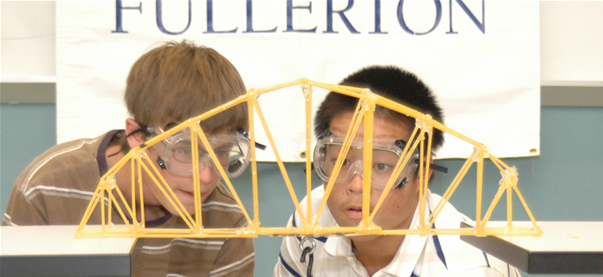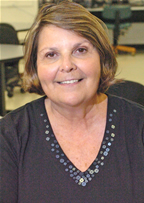It’s Sum-Sum-Summertime in the… Classroom?
OC High School Students to Attend University-Level Engineering Course
June 18, 2007
By Russ Hudson
It’s summertime, summertime
Sum, sum, summertime
Summertime, summertime
Sum, sum, summertime…
Well, shut them books and throw ‘em away’
And say goodbye to dull school days
Look alive and change your ways
It’s summertime
[“Summertime,
Summertime” by The Jamies]
For four weeks this summer, 16 area high school juniors and seniors are going to shut out The Jamies’ message of shutting their books in order to pursue a loftier goal: completing a 12-week Johns Hopkins University beginning engineering course in a single month at Cal State Fullerton.
They will be taking the Johns Hopkins’ “What Is Engineering” course from July 9 through Aug. 3. The course is offered to area high school students from educationally disadvantaged backgrounds who show promise in math and science and have maintained at least a 3.0 grade point average and completed required classes. The course, brought on campus by the Mathematics, Engineering, Science Achievement (MESA) program, is designed to dispel misperceptions about engineering and encourage students to go to college.
The program is intense with morning lectures
and labs in the afternoon, as well as a number of projects to complete
and work to take home.
“Last year, we had 14 highly motivated high school juniors and seniors,” recalled
Russ Hill, a MESA adviser at Costa Mesa High School, one of seven participating
high schools. The other high schools are Segerstrom, Santa Ana, Century, Saddleback,
Anaheim and Savannah. In addition, there are three students from the Tiger
Woods Learning Center in Anaheim.
“Most of them studied until very late at night, often 2 a.m.,” added Hill. “I know this because some would e-mail questions at that hour.
“The culminating activity is the spaghetti bridge-building competition,” he said. “They have to determine the properties and behavior of the spaghetti under load-bearing stress, determine a design that will provide maximum strength, then execute the design, using only spaghetti and epoxy.
“At the end of the four-week course, they reminded me of how I felt at the end of fraternity hell week: dazed but relieved,” Hill said. “I think they proved to themselves that they had the discipline, work ethic and ability to accomplish anything they put their minds to. We were as proud of them as they were of themselves. It makes me really look forward to working with this year’s students.”
Participating students are given significant incentives: the top two will be offered Cal State Fullerton engineering scholarships, and all students who complete the program with a grade of B or better will get three credit units from Johns Hopkins.
But they get more out of the program, no matter their grade, said Vonna Hammerschmitt, CSUF MESA director.
“There is quite a transformation,” she said. “They arrive here apprehensive, timid. They don’t know each other, typically. Then they are thrown together on projects and must collaborate on problem-solving and overcoming obstacles.
“We see teamwork develop … relationships start. We see them studying together on the bus on the way to school and from. They exchange e-mail addresses so they can continue to communicate after classes,” said Hammerschmitt, adding, “and they walk in tired from being up late doing homework.”
Then comes the real payoff for the teachers: “You start to hear them talk to each other,” Hammerschmitt explained. “They are knowledgeable about engineering. They are awakened.”
That doesn’t mean that they all fall in love with engineering, Hammerschmitt said. There is a flip side, too.
“Some have said they learned a lot, they had fun, they formed friendships.
But now they also know they for sure don’t want to be an engineer.”
Whatever their decision, she said, almost all of them go back to their
schools in the fall and become leaders, especially in MESA.
Raman Unnikrishnan, dean of Cal State Fullerton’s College
of Engineering and Computer Science, has often pointed out evidence
that high schools in California typically do not introduce students
to the engineering professions, let alone give good explanations of
engineering.
“There are a great number of students who do not choose engineering because
they don’t understand the profession,” he said during last year’s
Johns Hopkins course. “This summer program provides a rare and highly
desirable opportunity because the students not only receive an excellent understanding
of the engineering profession in general, but they also receive a good introduction
to the branches of engineering.”
“At first, I was reluctant to come,” recalled Taylor Smith of Segerstrom Fundamental High School in Santa Ana, who attended the program last summer, earned an A and was offered a scholarship to Cal State Fullerton when he graduates from high school. He will be back this year, but this time as the lab assistant.
“When the course syllabus was outlined and we began, I realized how interesting the topic was. By the end of the class, it really hit me how much application I had for this in my life, as well as how much I enjoyed doing the activities and solving the problems presented by the course.
“Before this course, I was inclined to go into a field of science … [Now] as far as my major, I definitely want to go into a field of engineering, eventually mechanical engineering, aerospace or biomedical engineering.”
Media Contacts: Vonna Hammerschmitt, MESA CSUF director, 657-278-3195
or vhammerschmttt@fullerton.edu
Russ
L. Hudson, Public Affairs, 657-278-4007 or rhudson@fullerton.edu


